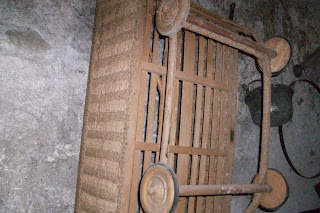Here in central Italy this has been a week “all’americana” with
my latest conference “La Tuscia vista dagli Americani “ at the Vetralla Library and several visitors from USA.
 |
| Fulvio shows off Vetralla's heritage |
Opening the season was Jamie Stoeffel of Indiana, winner of the Irish Trivia
quiz which I ran last month to
promote readers’ comments for this
blog. The best way you can show your appreciation for the information I share with you each week is to leave a comment at the end of the post.
 |
| official presentation of the Irish Trivia quiz prize |
Jamie received
her prize, a copy of “Travels to
Tuscany and Central Italy” with my personal dedication and then enjoyed cooking with Fulvio and lunch on the terrace.
 |
| Ramona and Jamie mirrored in the library |
She and her travel companion,
Ramona Fisher of Minneapolis, were happy to be
treated like VIP visitors after
having endured an encounter with gypsy pick pockets and the infamous “sciopero”
strikes that hit Italy’s transport system last week.
 |
| enjoying lunch |
 |
| Enrico Dolci, president of the olive oil cooperative, charms le americane |
 |
| homemade cinnamon digestivo |
They were thrilled to receive
gift bottles of Vetralla’s fine olive oil from the president of the
olive oil cooperative and even the local kids wanted to have their photo taken
with le americane.
 |
| with the kids of Piazza del Duomo, Vetralla |
Another group of 5 lovely ladies
of the same family dropped in for a
visit during their tour of the nearby Palazzo Farnese in Caprarola.
 |
| Ruud, Fulvio and American visitors in my library |
They were happy to have discovered the area
which offers such beauty and hospitality,
so close to Rome and Florence yet not touristy.
 |
| David and Todd interpreted early American writers |
Professor David Reinking, actor-neighbor Todd Carter, Lia Randazzo and Sydney Johnson students of the USAC program were the Americans who helped make the illustrated conference “La Tuscia
vista dagli Americani “ a huge
success on Friday afternoon at the Vetralla library.
 |
| Lia signing the guest book |
They read excerpts -in Italian-from
American writers of the 19th
century ( Mark Twain, Nathaniel Hawthorne etc.) describing
this part of Italy.
The audience of Italians, unaware of how their land (Tuscia /Northern Lazio/Etruria)had been perceived
by foreign visitors in the past, were horrified at the
many negative descriptions.
 |
| a part of the attentive audience |
 |
| a full house for Mary Jane's talk |
Central Italy has come a long way
since the days when American writers described filthy streets and
desolation due to malaria. Besides
the natural improvement of the
area, we must thank the images created by Hollywood films and writings by contemporaries living in the area among these
 |
| the audience came from Sutri, Viterbo, Rome, Soriano, Bracciano and a few from Vetralla |
Linda Lappin's mystery novels, Eleanor
Herman’s story of Donna Olympia,
“Mistress of the Vatican” and Mark
Leslie’s amusing description of life (and learning to cook ) with a local family.
Thanks also go to social media tools Facebook and
blogs which have made journalists
and promoters of all those who come to visit
and remain enchanted with the quality of life in Etruria.
Thanks
to all these things, a special part of Italy, unintentionally ignored by American visitors, is
finally coming out of its centuries-long slumber. This year Italy has been named as the number one destination for adult Americans for a visit outside their own country.
 |
| Mary Jane presenting "La Tuscia vista dagli Americani" |
For the past eight years it has held the first and second places for best vacation destination. This was no surprise to marketing specialists who consider Italy as the top destination for romance, culture, history,fine food and wines.
Be sure to visit my website for practical information and books about the area and share with friends and family.
Your comments and feedback are welcome.





















































